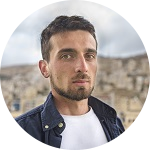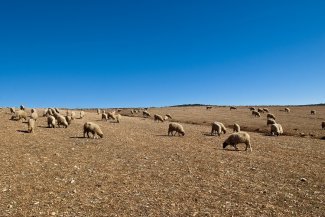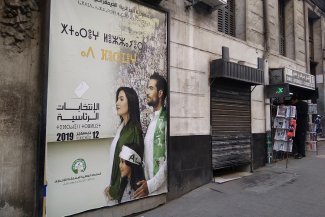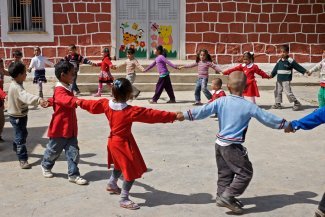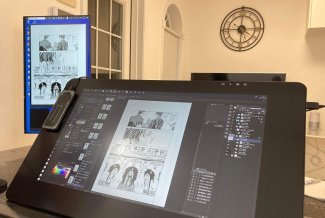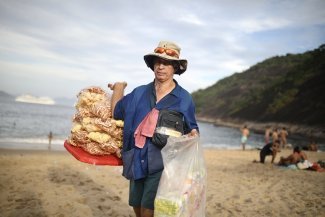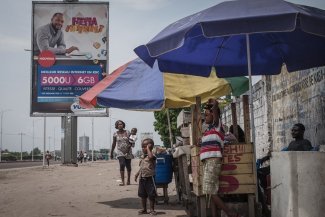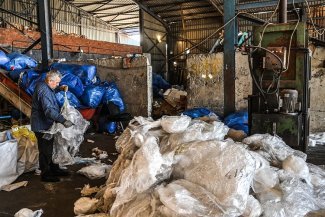In this photo taken on 10 September 2023, a family take shelter in a makeshift tent on the outskirts of the earthquake-stricken town of Amizmiz. More than 3,000 people were killed and an estimated half a million people were displaced by the 6.8-magnitude earthquake that hit Morocco on 9 September 2023. Almost two months later, impacted rural communities are still unsure about how and when reconstruction efforts will take shape.
As harsh mountain winter looms in the earthquake-ravaged village of Tafeghaghte, nestled on the High Atlas Mountains about 60 kilometres south-west of Marrakesh, 36-year-old Fatima Azem feels a growing sense of urgency while packing her family’s belongings into her cousin’s car. “We can’t wait for the reconstruction process. Our only option is to move to my cousin’s home in Essaouira [over 400 kilometres away] and start anew.”
After the earthquake that struck on 9 September 2023, Fatima’s agricultural family lost their home and livestock, which had been their primary source of income, as it was buried beneath the rubble of their village, which is close to the quake’s epicentre. Tragically, Fatima also lost her parents in the destructive tremors that levelled the entire village and claimed the lives of half of Tafeghagte’s 200 residents. Now, survivors are compelled to reside in tents, much like tens of thousands of others facing similar circumstances.
More than 3,000 people were killed and at least 59,674 houses were either damaged or destroyed, displacing over 500,000 people according to the US-based NGO Data Friendly Space, mostly from the marginalised agricultural Amazigh community living in mountainous douars (villages comprising tents and huts), isolated from essential services such as healthcare and education.
As the dust from the earthquake settles, a poignant dilemma is unfolding in the remote corners of the Atlas Mountains. Faced with the prospect of a slow rebuilding process and potential relocation, Fatima’s family of five, who belong to the Berber Amazigh minority, has reluctantly decided to migrate to the city, echoing the choices made by numerous others who are uncertain about their future in the Atlas Mountains.
“We don’t like the city lifestyle. We are attached to our village and will not give up on rebuilding our home if we are given the opportunity. However, with the harsh winter approaching, we feel we have little choice,” Fatima tells Equal Times.
Despite announcing an €11 billion budget for reconstruction, including some €2,735 of direct assistance per household and up to €12,765 for each destroyed housing unit, Morocco’s King Mohammed VI has yet to provide a clear roadmap for the way forward, leaving the affected communities in limbo. The United States Geological Survey has estimated earthquake-related losses to be as high as €10 billion – some 8 per cent of the country’s GDP.
The earthquake, striking Amazigh villages heavily reliant on pastoralism and agriculture, exacerbated their preexisting struggles with fragile infrastructures, job scarcity, precarious living conditions and the forced privatisation of tribal lands, thrusting into the spotlight urban-rural development disparity in Morocco and the potential rural communities’ migration towards urban centres.
“The risk of depopulation is real. Although they feel a deep attachment to their douars, those who have the opportunity will not wait for the lengthy reconstruction process. Migration will primarily affect the younger generation, who will likely move to already overcrowded cities,” says Rabat-based political analyst Mohamed Chtatou, himself an Amazigh. “However, the Amazigh tend to recreate the same forms of solidarity found in their villages, keeping their roots firmly grounded,” he adds.
Annually, 150,000 internal migrants depart Morocco’s rural areas in search of employment opportunities in urban centres.
A budget and a king’s promise
The promise of direct assistance per household and funding for rebuilding damaged homes offered a glimmer of optimism in the aftermath of the disaster, but the absence of a clear roadmap for reconstruction is leaving families with uncertainties about their future.
The small yellow tent provided to Hamdi Aïtbrahim’s family of six offers little space in the battered village of Ijjoukak. He’s convinced the government’s financial aid won’t stretch far enough for a home in Marrakech, a two-and-a-half-hour drive away and the primary economic hub of the region, where he envisions better prospects for securing a new job and supporting his family. “With my house in ruins, my wife and parents lost in the rubble and five kids to take care of, and winter closing in, what shall I do? I’m contacting my extended family hoping they can take us in while I search for work in Casablanca,” Hamdi confides.
Hamdi’s car repair shop also crumbled in the earthquake, rendering him unemployed, with just two out of ten sheep from his herd surviving under the rubble. As winter draws near, with temperatures dropping several degrees below zero and the mountains getting covered by thick blankets of snow, lack of shelter make it impossible for his family to stay in the tent. “I would only stay here if I could rebuild my house right away. I need a solution.”
The crucial question of whether the long-neglected rural villages will be reconstructed in their original spots or shifted to urban areas remains unanswered. While some advocate for rebuilding in place to safeguard the cultural heritage and traditional lifestyles of these communities, others argue that relocating them to urban centres or reconstructing them in safer locations nearby, with improved access to services and opportunities, is a more practical option.
While earthquakes cannot be predicted, Morocco’s proximity to the African plate and its location atop a web of active faults, particularly within the High Atlas mountain range, suggests that future seismic activity may be unlikely.
Though large-scale earthquakes like the recent one are relatively rare, Morocco has experienced significant tremors in the past. Notably, two such events took place in the northern Al-Hoceima region in 2004 and in Agadir in 1960, resulting in the tragic loss of over 600 and 15,000 lives, respectively.
Architect and former President of the Architects’ Council of Morocco, Omar Farkhani, warns against the technocratic temptation of rebuilding entirely new villages elsewhere, calling it a doomed endeavour. “These douars are currently underdeveloped habitats, historically disadvantaged and neglected. The focus should be on enhancing the existing agricultural ecosystem and addressing long-standing inequalities,” he tells Equal Times. He contends that the ongoing rural exodus for those without a solution is not just inevitable but necessary: “By its very nature, the rural world has limited capacity to feed its children. The earthquake has intensified this dynamic.”
Farkhani argues that reconstruction efforts should favour the broader rural community, enabling them to remain in their region, rather than primarily benefiting the construction industry eager to secure contracts.
During his field mission with a team from the Ministry of Housing, some residents of the affected mountainous villages expressed to Nabil Mekaoui, an engineer from the Mohammadia School of Engineers, their desire to rebuild their homes with concrete. They blamed traditional architecture for the buildings’ collapse in the remote villages on the mountains. “The public debate is polarised between supporters of concrete and advocates of traditional materials. It’s misleading. We should focus on the earthquake-resistant capacity of the main structure,” he tells Equal Times, emphasizing the need to bridge the research gap regarding the technical properties of stone and earth in the hard-hit Al Haouz region.
The road ahead
Despite King Mohammed VI’s call for “accelerating the reduction of social deficits, especially in the mountainous areas affected by the earthquake,” existing development policies for rural regions struggle to address what the colonial French administration once labelled as ‘useless Morocco’, referring to regions deemed unproductive and consequently neglected in the country’s economic development.
In 2017 the Conseil économique, social et environnemental (CESE) emphasised that development policies since 1956 had failed to generate wealth for the local population, leaving rural regions “in a state of isolation and underdevelopment detrimental to meeting the needs of the population and promoting development.” With 40 per cent of the population residing in rural areas, the contribution of these regions to the national GDP is less than 5 per cent.
The permanent resettlement of 30,000 citizens after the 2004 Al-Hoceima earthquake took over two years. Now, facing a tenfold increase in scale and a larger area without adequate infrastructure, the challenges are even greater. Since the 2004 earthquake, the coastal Tanger-Tétouan-Al Hoceima region has seen a resurgence, largely thanks to a thriving tourism industry. The GDP per capita in this area stood at 34,751 MAD (€3,215), slightly below the national average. However, the outlook is less promising for the recently quake-hit Marrakech-Safi region, where the central and eastern arcs of High Atlas extend, one of the nation’s poorest regions with a per capita GDP of just 20,971 MAD (€1,943), notably below the national average.
“The Amazigh community living in the High Atlas hasn’t been provided with conditions to live in dignity. We experienced similar dynamics during the 2004 earthquake in the Rif region, where families migrated as they didn’t have enough resources to rebuild their lives. The land may be left empty,” decries the Rif Tribes Foundation, a youth-led Amazigh charity.
"If the prevailing approach is to build entirely new villages, uprooting people from their land, we could end up with cramped living conditions similar to French social housing in the suburbs. However, the statements from the Royal Cabinet are reassuring in this regard,” warns Mohamed Dich, the president of the Civil Coalition for the Mountains, an organisation dedicated to empowering mountainous communities.
He argues that rural migration can be prevented if the authorities see the reconstruction process as a chance to implement development policies in mountainous regions, with a focus on agriculture, tourism, and community-driven rebuilding. However, some officials have hinted at the possibility that relocating affected individuals could be the preferred choice, a decision that could have profound implications for the Amazigh community, where land holds significant cultural significance.
Morocco faces a challenging path to rebuilding, with the well-being of its rural communities hanging in the balance. In December, snow blankets the High Atlas Mountains, leading to power outages, road closures, and isolated villages. This year, the vulnerability of temporary housing makes these challenges even more daunting.
Fatima, facing the tough choice of temporarily leaving her ancestral home, reflects on her family’s difficult decision. With the car packed and their journey to a new life in Essaouira on the horizon, her voice tinged with determination, she states: “As we leave behind the remnants of our life in Tafeghaghte, our roots remain in the mountains. It’s a new beginning, but the Atlas Mountains will always be our home.”



